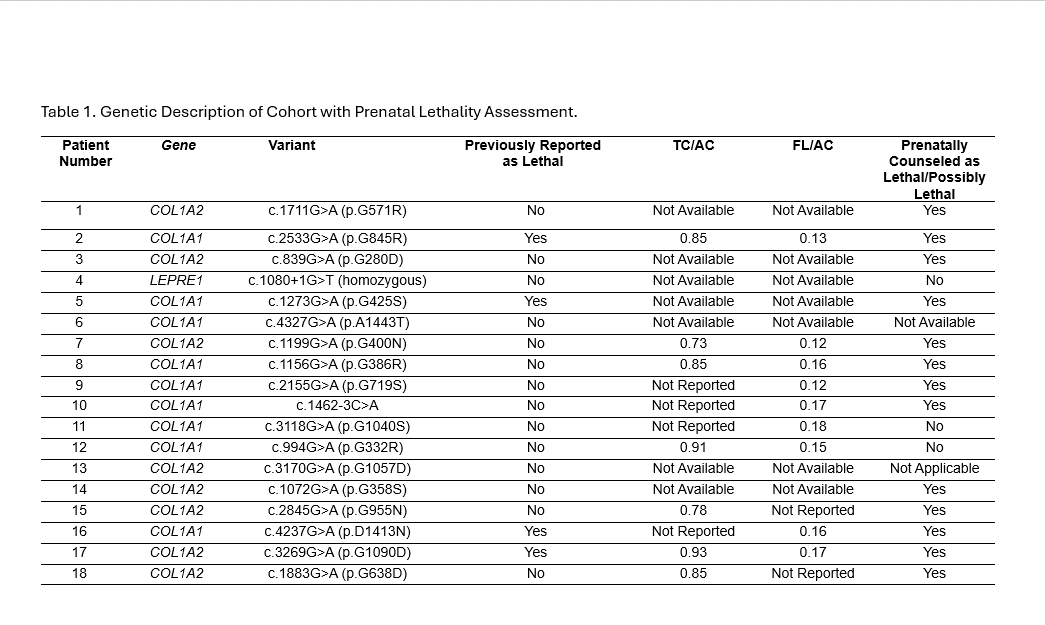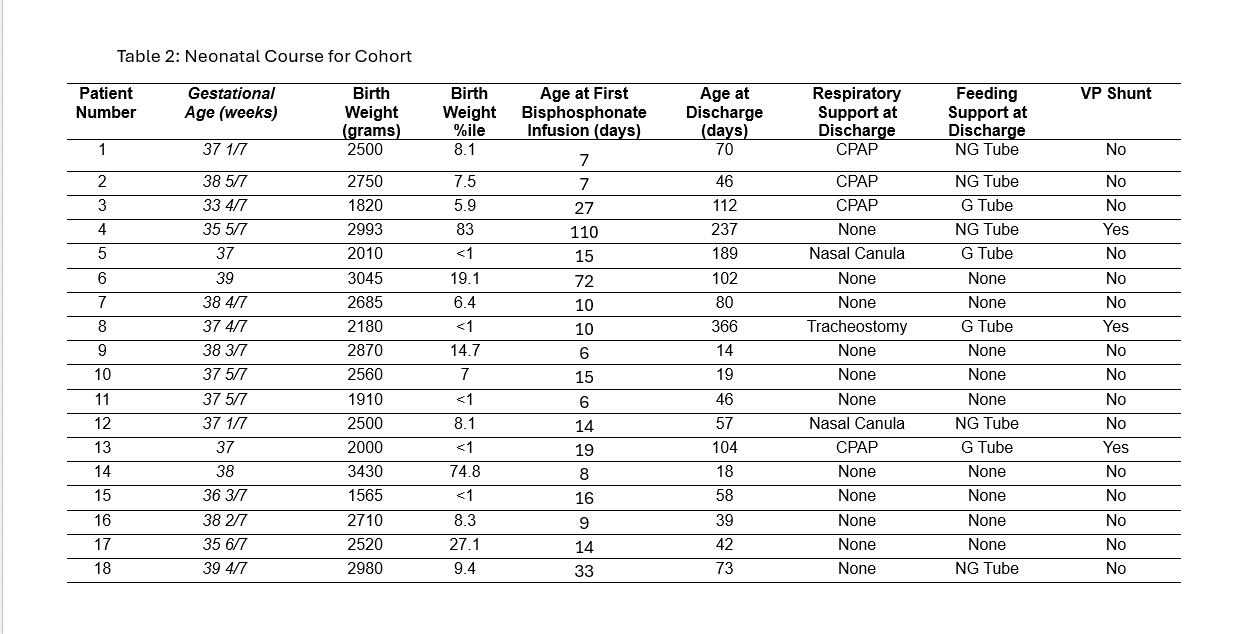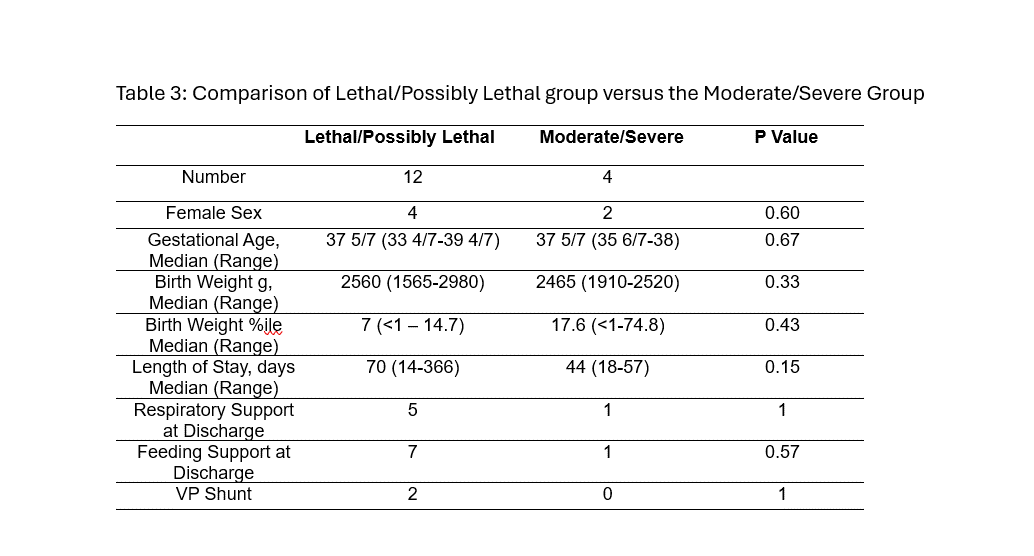Neonatal General 11
Session: Neonatal General 11
416 - A Single-Center Experience of Neonates Prenatally Diagnosed with Osteogenesis Imperfecta: Most Infants Survive Without Need for Longterm Respiratory or Feeding Support
Monday, April 28, 2025
7:00am - 9:15am HST
Publication Number: 416.3899
Ricki S. Carroll, Nemours Children's Hospital, Wilmington, DE, United States; Sarah Little, Nemours Children's Hospital, Wilmington, DE, United States; Tina McGreal, Nemours Children's Hospital, Wilmington, DE, United States; Shannon Bonner, Nemours Children's Hospital, Wilmington, DE, United States; Daria Willis, Sidney Kimmel Medical College at Thomas Jefferson University, MIDDLETOWN, DE, United States; Jeanne Franzone, NemoursAlfred I. duPont Hospital for Children, Wilmington, DE, United States; Jeffrey W. Campbell, NemoursAlfred I. duPont Hospital for Children, Wilmington, DE, United States; Margaret R. Chou, Nemours Children’s Health, Wilmington, DE, United States; Megan Raymond, Thomas Jefferson University, Philadelphia, PA, United States; Andrea J. Schelhaas, Nemours Children's Hospital, Wilmington, DE, United States; Joanna Costa, Nemours Children's Hospital, Landenberg, PA, United States; Mahim Jain, Sidney Kimmel Medical College at Thomas Jefferson University, Wilmington, DE, United States
- JC
Joanna Costa, MD (she/her/hers)
Neonatologist
Nemours Children's Hospital
Landenberg, Pennsylvania, United States
Presenting Author(s)
Background: Moderate or severe osteogenesis imperfecta (OI) is often diagnosed prenatally based on ultrasound findings and/or genetic testing and may be labeled as lethal. However, it is often difficult to predict the severity of OI in utero. Additionally, advancements in medical technology and the option for life-sustaining interventions may allow even severely affected infants to survive.
Objective: We sought to describe neonatal outcomes in patients prenatally diagnosed with OI cared for in a single quaternary center.
Design/Methods: Inclusion criteria were any infant with OI who received care in the NICU, regardless of birth hospital. We completed a comprehensive chart review including prenatal, birth, neonatal, pediatric medical and surgical histories. We specifically examined reported ratios at second trimester anatomy ultrasound including femur length to abdominal circumference (FL/AC) and thoracic circumference to abdominal circumference (TC/AC) when available, as well as qualitative narrative comments. Genetic variants were reviewed in ClinVar for prior description of lethality association.
Results: Between 2019 and 2024, 18 infants with OI received neonatal care at a single center, 10 of which were inborn. Of these, 12 were previously counseled toward a lethal or possibly lethal form in utero. All 18 infants survived to hospital discharge. Seven infants required some respiratory support, and 9 infants required some feeding support at discharge. We did not observe that a lethal or possibly lethal prenatal diagnosis correlated with medically relevant outcomes such as need for respiratory or feeding support at discharge. There was no statistically significant difference in length of hospital stay in the lethal/possibly lethal group (median 70 days, median 14-366 days) compared to the nonlethal group (median 44 days, range 18-57 days).
Conclusion(s): With a multidisciplinary team approach to neonatal care, outcomes may be optimized in individuals with OI. Infants formerly diagnosed with lethal OI may survive. Given our findings, and lack of correlation of prenatal assessments with survival and other medical outcomes, we recommend all families be given the option to pursue life-sustaining medical interventions.
Table 1. Genetic Description of Cohort with Prenatal Lethality Assessment

Table 2: Neonatal Course for Cohort

Table 3: Comparison of Lethal/Possibly Lethal group versus the Moderate/Severe Group


